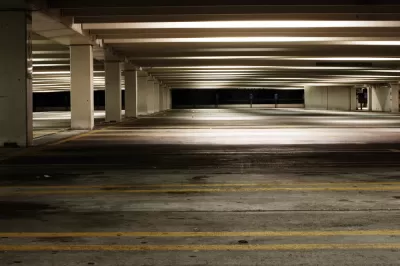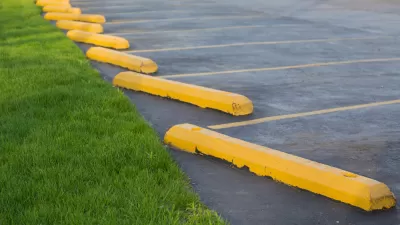In cities big and small, the tide is turning against sprawling parking lots, car-centric development, and minimum parking mandates.

American cities, designed for decades to accommodate private cars, are starting to see the benefits of reducing the amount of land used for parking and supporting other transportation modes.
According to an article by Jane Margolies in The New York Times, “The United States has about two billion parking spots, according to some estimates — nearly seven for every car. In some cities, as much as 14 percent of land area is covered with the black asphalt that engulfs malls, apartment buildings and commercial strips.” But today, as housing costs rise, housing supply fails to keep up with demand, and the negative impacts of sprawl and carbon emissions are more broadly understood, minimum parking requirements—mandates that dictate how much parking a developer must provide for a project based on the project’s use, and that often call for more parking than actually needed—are being revised or eliminated in cities and states around the country. Shifting work patterns are also reducing the need for parking in some areas, making it a good time for cities to evaluate the need for parking mandates.
Margolies outlines the history of off-street parking in the U.S., which correlates with the rise of private car ownership. “In the postwar period, when Americans were in thrall with the automobile and the federal government unfurled highways across the land, parking minimums were enshrined in zoning codes to ensure that Americans would always find a paved parallelogram waiting for them at the end of their trip.” Margolies explains that these mandates were not based on any real calculation of need, but became enshrined in the zoning codes of most cities.
Aside from promoting car ownership and inducing sprawl, parking requirements also drive up the cost of development. “Even a basic, stand-alone parking structure costs nearly $28,000 per spot on average, not including land, said Rob McConnell, a vice president at WGI, an engineering firm.” Parking reform advocates like University of California, Los Angeles (UCLA) professor Donald Shoup have spent decades arguing that parking policy has a major impact on housing and transportation costs, urban design, mobility, walkability, and quality of life.
Margolies highlights the success of the first major U.S. parking reform program in Buffalo, New York, where “A 2021 study revealed that after the repeal, new major developments overall had 21 percent fewer spaces than the minimum parking mandates would have required.” Other reforms followed at local and state levels, signaling a growing movement to reimagine how parking fits into cities.
FULL STORY: Awash in Asphalt, Cities Rethink Their Parking Needs

Alabama: Trump Terminates Settlements for Black Communities Harmed By Raw Sewage
Trump deemed the landmark civil rights agreement “illegal DEI and environmental justice policy.”

Study: Maui’s Plan to Convert Vacation Rentals to Long-Term Housing Could Cause Nearly $1 Billion Economic Loss
The plan would reduce visitor accommodation by 25% resulting in 1,900 jobs lost.

Planetizen Federal Action Tracker
A weekly monitor of how Trump’s orders and actions are impacting planners and planning in America.

Waymo Gets Permission to Map SF’s Market Street
If allowed to operate on the traffic-restricted street, Waymo’s autonomous taxis would have a leg up over ride-hailing competitors — and counter the city’s efforts to grow bike and pedestrian on the thoroughfare.

Parklet Symposium Highlights the Success of Shared Spaces
Parklets got a boost during the Covid-19 pandemic, when the concept was translated to outdoor dining programs that offered restaurants a lifeline during the shutdown.

Federal Homelessness Agency Places Entire Staff on Leave
The U.S. Interagency Council on Homelessness is the only federal agency dedicated to preventing and ending homelessness.
Urban Design for Planners 1: Software Tools
This six-course series explores essential urban design concepts using open source software and equips planners with the tools they need to participate fully in the urban design process.
Planning for Universal Design
Learn the tools for implementing Universal Design in planning regulations.
Caltrans
Smith Gee Studio
Institute for Housing and Urban Development Studies (IHS)
City of Grandview
Harvard GSD Executive Education
Toledo-Lucas County Plan Commissions
Salt Lake City
NYU Wagner Graduate School of Public Service





























